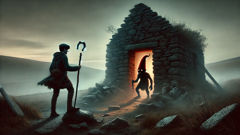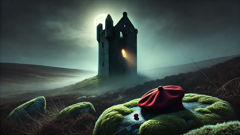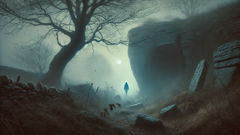Introduction
The moss that crept over the stones of the old peel tower had a deep, patient green, and in its folds the borderland kept its secrets. Wind came down from the Cheviots in knives and strings, carrying peat-smoke and the metallic memory of rain. Where sheep tracks threaded the heather and where the burn ran over black rock, people said the Redcap walked. They called him a goblin, a spirit of malice made small and malign, a creature who kept his time between dusk and the dim hours of the night. What made him dreadful in every telling was not merely the way he peaked through shutters or left footprints too small and too swift for any known animal. It was his cap — a coarse red bonnet that the old women said he dyed in fresh blood. The transformation of cloth into terror was the proof that this thing did not merely haunt dreams; it had cruelty and method. It lived in the spaces that had once been human: ruined farms, ruined hearths, the narrow rooms of towers abandoned after a raid or a famine. Men who had faced reivers and trackers in daylight found themselves small and foolish beneath the Redcap's gaze. Mothers taught children to cross themselves at the sight of a sea of red mushrooms, to carry iron from the smith's forge in a pocket, to leave saucers of milk by a threshold. Chapman and parish both collected stories and talismans: a pebble with a hole through it, a sprig of rowan, a shard of iron. The stories obeyed no tidy logic; they piled like stones at a cairn, each adding weight and warning. In the simplest telling the Redcap was a punishment for cruelty; in another, he was a hungry ghost who had once been a border reiver, dying with a thirst for violence. Still others swore he was older than men’s quarrels, older than the line of the kings, a thing of the earth and the wet cliff-face.
Through winter and summer, the border folk kept living, their agriculture bled into the patterns of fear and habit. There were rituals: nails hammered into thresholds, prayers said under breath, and holes in bread left for a passing sprite. The Redcap was woven into these acts until he was indistinguishable from the landscape: part superstition, part social glue. To speak of him was to explain the cruel: a stray child, a missing traveler, a hound found with a throat torn—each could be read by anxious minds as the Redcap's work. And yet beneath that explanation moved a human stubbornness, the refusal to give ground to a tale no matter how real the danger felt. This story is not the single, simple myth told by a collector who wrote his notes quickly. It is the long, layered account of the creature who walked the border; of the families who survived by caution and cunning; of the man who faced the Redcap and of the wound that changed him. It traces both a creature and a community, and asks what happens when an old fear becomes a living thing with its own hunger. The tale unfolds among stone and peat, on roads rimed with frost, beside wells where the water knew the names of every villager; it gathers fragments of everyday life and binds them with the red thread of a cap dyed once, they said, with blood and forever after blooming like an open wound on the land.
Origins and Old Beliefs: How the Redcap Came to the Border
They said the Redcap was older than the treaty stones, older than the line drawn and redrawn across the heather and river. In the first telling, whispered by shepherds in wet coats leaning toward peat fires, the Redcap was born of pride and cruelty. Once, the story went, there had been a man — a cruel tenant or a reiver who delighted in the unmaking of others — who killed at whim and built his house upon bones. The community could not come to a consensus on how to punish him: some called for exile, some for violence, some for prayer. In the end, grudges and fear braided into a verdict half-human and half-spell. Those who kept knowledge and talisman — wise women, old men with memories of war, villagers whose craft was salt and rope — agreed to bind his will to the stone with rites no one in daylight could fully recall. A rope of hawthorn and rowan was braided; a bell was silenced; the man, already half-mad with bloodlust, was brought to the tower and left beneath an iron night. When he was no longer a man in body, they said, his malice clung to the cloth of his cap, and the cap drank blood and grew redder until it shone with a hatred that was not mortal. In other retellings, less tidy and far older, the Redcap is not born of one man but of the land itself. Borderlands, people said, had always taken what they needed: a family here, a harvest there, and the land kept a tally. The cap, dyed in the spill of life, was the ledger's color. That version suited those who believed in boundary spirits: creatures who marked the line between safe and unsafe, between loosed and bound. When men crossed into the wrong place at the wrong time—whether raiding, or cutting peat on another's turf, or leaving an infant alone—the Redcap appeared as punishment.

Whatever the origin, his habits were constant in people's accounts. He favored ruins and towers where blood had once been spilled, where the mortar remembered a hand's heat. He moved at night with a speed that made dogs hair-raise and cattle turn toward their homes. He left no tracks larger than a child's footprint, but he left signs all the same: a smear on a sill, a red feather on the path, a scuff of iron where a lantern had been dropped. The villagers developed a vocabulary of gestures and implements to contend with him. Iron was the most frequent defense: a nail hammered above the door, a horseshoe nailed to the lintel, a smithed spike laid beneath a threshold stone. They said Redcaps could not stand the smell of iron forged hot, and they kept an emergency iron in a larder for that reason only. Rowan wood found its way into belts and children's cradles; it was cut with care, stripped of bark in silence, and never burned in a hearth that might call the spirit near. Salt was a currency of warding: a pinch thrown across a doorstep, a small heap left in a bowl with a prayer for the safe passage of souls.
But folk law is not only a recipe book of protections; it is also a map of human relationships. The rituals the borderers observed to repel the Redcap became ways to check on neighbors. Knocking patterns on doors at dusk served to confirm presence and to count heads. A saucer of milk left by a door had a practical purpose—it drew vermin away from stored grain—but it also fed a need to perform comforts for things unseen. As much as these customs were protections from a supernatural predator, they were also social glue, reweaving trust in a region where trust had been torn by raids and sudden losses. At market, women bartered stories like other goods, trading a measure of oats for a telling of a safe route or a charm that insisted it had seen off a Redcap last autumn. The story's geography grew through that exchange: a marsh where he liked to crouch, a crag where he preferred to watch, a ruined chapel where his cap was found once on an altar. Each marker made the creature more real; each warning made the landscape smaller and more watchful.
There were tamings and bargains, too, in some accounts. A few tales insist that the Redcap could be bargained with like any reiver: leave a payment in blood or iron at his favored stone, and he would leave you to your days. Others told of a wise man—half-priest, half-cunning—who could force the cap off and capture it in a sack of linen, but these were dangerous operations; the cap fought with the strength of an accusation, and often the captor's hands bled until the cloth took the hue it wanted. In the worst of stories, men tried to strip the cap and found that it could not be cleansed; its dye was not of pigment alone but of pattern and purpose. When rubbed with soap and ash, it stained hands like memory. The Redcap then became something that could not be wholly removed, a mark on the land and an inheritance of sorrow.
As time passed and the reivers were driven to other pursuits, as treaties are written and rafts of soldiers marched away, the Redcap's appearances changed in tone. He remained a cautionary tale for reckless lads and for those tempted to trespass. In some records collected by antiquarians and later by folklorists, the Redcap is described in clinical terms: a nocturnal small man with cruelty in his eye and speed in his limbs. In others, he is more spectral—a stain that moves, a pocket of cold that swallows breath. The telling mattered because it showed how communities adapted their fears to the shape of the times. Where once he might have been explained as the ghost of a particular man killed in revenge, later storytellers spoke of him as an emblem of the border's cruelty, a scar left by endless conflict. That scar needed tending, and tending turned into ritual. That ritual kept the boundaries between neighbors visible and set the rules for a life where loss could be answered without becoming limitless.
Beyond the rituals, the Redcap's story gathered human faces. Wives who had lost husbands in the raids told of glimpses in the doorway, of a hat perched stiffly on a stone; shepherds swore they had seen a childlike figure run and then vanish; bards adapted the tale into songs that traveled to inns and then back into the art of telling. The Redcap, in this sense, belonged as much to the border people as did the rivers and the old roads. He was the place where grief altered the nature of things, where community invention made monsters tangible and survivable. To know him was to know a people's way of naming wrongdoing and of binding harm to a shape so that it might be resisted. And resist they did—by iron and rations, by rows of rowan and the soft mutterings of prayer—transforming fear into a set of shared actions that made the night less arbitrary. The creature's cruelty kept the border quiet in one way: people learned a thousand small habits that kept them alive, and in doing so they taught each other that even the oldest terrors could be answered by the steady, stubborn work of living together.
The Night Thomas Met the Redcap: A Border Confrontation
No story of the Redcap ever felt completely separate from human detail; the monstrous only became legendary by way of human suffering and daring. In one such account, preserved in a family chronicle and told around many an inn hearth, a young borderer named Thomas Langley—son of a tenant farmer, wiry and quick, who knew the routes between lairs and croft fines—came face to face with the creature and changed the legend in the telling. It began as these things often did: with a wrong and a disappearance. A herd boy from a nearby fold failed to return from the hill. He had been last seen at twilight, a small figure against the track, carrying a pail and whistling for his dog. In the morning, there were signs: the pail torn, a smear of red on a low stone, the dog's paw-prints circling and then nothing. People said at once the Redcap had been at work; some swore it was the wind and wolves, but superstition moves faster than doubt when a child faces harm.

Thomas volunteered to search because he could not do less. He was not a man of particular piety; he had the practical belief of people who survive by knowing the land. He took with him what every sensible borderer would take: an iron-tipped staff, a small hammer from the shed, and a piece of rowan in his pocket. He walked the low road toward the moor where the boy had been last seen, feeling for the traces others described with their urgent, desperate narrations. The sun set like a coin behind the hills, and as the dusk turned the world to some other's scale, Thomas's eyes caught things that daylight had hidden: a new stone shifted on the path, the impression of fingers small and many upon a ledge, a faint red stain that might be rust or might be something worse. He followed these signs until he reached a hollow where a ruined watchhouse leaned like a man bent in prayer.
The hollow smelled of damp wool and a sweetness like old bread gone sour. There, crouched beneath the shelter of a collapsed curtain-wall, the Redcap sat. Even from afar Thomas could see the cap: a thick, knitted thing, absurdly bright against the gloom, and on the stone at its feet lay a small, broken pail with a streak of red much too vivid for peat. The creature looked up without haste, and the effect of its look was immediate: Thomas felt his limbs narrow. The Redcap's stature was no more than a manchild's, but its eyes held a way of counting need and making argument out of hunger. It had the face of a thing that had laughed at cruelty for a long time.
Courage in the border is often less about fearlessness than about calculation. Thomas kept his breath and did what the old wives' manuals suggested and the smiths' counsel reinforced: he hammered the head of his staff into the ground, drew upon his belt a horseshoe, and set it across the hollow's threshold. He laid a length of rowan at his feet and spat a small pinch of salt over his shoulder. The Redcap cocked its head as if listening, and the watchers who would later retell the event insisted the creature hissed in a way that made the iron ring like a bell in the dark. It was not merely the physical clanks that mattered, but the claim: iron was order, and the Redcap was a kind of lawlessness. For a moment Thomas imagined all the centuries of men who had done the same thing. He held the image like an amulet.
Then the creature moved. The speed of it was blurring; Thomas swung his staff on instinct, aiming at the cap. The Redcap did something that would be told differently by different mouths: some said he leapt like a hare; others said he melted out of the shadows. One constant remained—when Thomas's staff met the cap, it felt as if he had struck the hinge of a door. The Redcap shrieked, and for a stuttering instant Thomas saw not only the red of cloth but something darker and fluid within, like the memory of old wounds. The cap came away, and the air smelled of iron and of peat and of a far-off, ancient bleaching of bone. Men recorded that whenever the cap was disturbed it protested; its color deepened as though feeding on wrath. In the pulling, Thomas's palm was cut, and the wound took the dye as if it were made to accept that color. He did not notice at once the slow absorption of the stain into his skin.
What followed was a negotiation of force and cunning. Thomas wrapped the cap in his coat and tried to bind it with a rope of hawthorn thrown hastily over a fence. The Redcap leapt and tried to recover its cap as a hound recovers a bone. Thomas hammered his iron into the earth and called for help, but the hollow was given to distance and to echoes that die before they arrive at a neighbor's ear. He ran with the cap clutched under his arm like contraband. He thought of the chants he'd heard from older women: 'Bind it with rowan, bind it with tongue.' He spoke words he had not known he could say, words half-prayer and half-admonition, and at times the cap seemed to shiver as though listening.
By the time Thomas reached home, the stain on his hand had darkened into something not quite blood, not quite rust. His thumb, when he looked at it under the lamplight, had a crescent the color of old jam. His mother shrieked when she saw it; his father squeezed his shoulders and whispered he would go to the kirk, and the whole household leaned toward the cap as though toward danger. There were those who counselled immediate combustion: burn the cap and let the matter end. There were those who insisted on taking it to the minister, to be prayed over and bound by words of scripture. Thomas's wound was not superficial; where the dye had soaked into skin it left an itch like memory. That night, he dreamed of red clouds and a cap sitting on his chest. He woke with the taste of iron on his tongue.
The days after were a slow unraveling of certainty. The Redcap seemed to multiply, or perhaps the story multiplied—it is hard to unpick whether more sightings were due to the thing's appetite or to the community's sensitivity. Sheep were found with necks neatly cut, a woman on the lane said she'd felt a tiny, cruel hand lift the hem of her dress to steal a coin. Above all, there was a fear that by removing the cap Thomas had invited a curse upon himself and his family. The parish split between those who believed the cap must be destroyed in holy fire and those who argued it must be kept and studied as one keeps an enemy close. The minister advised against blasphemy; the wise woman advised an ancient remedy: a stitch of rowan must be sewn into the hem of the cap, and a vow taken by the family that no man would cross another's threshold for bread or to take a child's name without permission. Thomas, for his part, felt the dye's slow warming in his veins, a tension like a promise. Whether it was guilt or guilt's twin—responsibility—he could not say.
There was a reckoning in the field where the sheep were found, beneath a sky so thin and prescient it seemed to bear witness. Thomas, my neighbor's great-grandfather used to say, set the cap upon a stone and asked the thing to speak. He had no means to force it to answer but he had something worse: he had time and a stubbornness bred of the border. He set down iron and spoke aloud the names of the lost, the wronged, and the living. The cap made a small sound, almost like breath, and the stain on Thomas’s hand burned for an instant with the color of accusation. In some versions the cap answered in words like a child's snarl; in others, it remained a thing of mute hunger. The crucial detail, persistent across the many tellings, is that Thomas did not kill the cap. He trapped it in cloth, bound it with rowan and iron, and placed it inside the kirk's old chest where relics and old oaths slept. The minister refused to have it nailed into the altar; the wisdom of those who had known the ways of spirits suggested containment, for killing a thing sometimes frees what you sought to confine.
The wound on Thomas's hand never quite faded. It remade itself into a scar that was a small, red crescent. People made of it a sign: either of bravery, or of the curse that clung to those who wrestled with things of old power. His descendants would show children the mark and tell them the tale in a tone meant to do two things: to entertain and to instruct. The Redcap's appearances dwindled, or perhaps the telling became more cautious. When trade routes shifted and the border became kinder through law and the ever-widening reach of crown order, men had fewer reasons to trespass or to quarrel over a field at two in the morning. Yet the memory of the Redcap endured because it showed how a community coped: by ritualizing fear, naming wrongs, and building a set of practical defenses that kept the night manageable. Thomas's story joined that tradition and added a further lesson: confronting a horror does not mean destroying it outright; sometimes it means containing it, and in containing it one accepts a permanent reminder of risk and of vigilance.
Conclusion
Legends do a cunning thing: they preserve not only fear but community strategy. The Redcap persisted across centuries because people needed a name for sudden cruelty and a ritual for surviving it. To the borderers, the cap was both a hazard and a lesson—an emblem of the harm that crosses property lines and human decency, and a test of the small civic rituals that hold a fragile peace. Modern readers might find the notion of a blood-dyed cap grotesque or quaint, but for those who lived with the threat it carried an obvious warning. Carry iron. Keep rowan. Leave a saucer for what you cannot name. Tell the tale at market and in the kirk and in the peat-smoke of the kitchen until the steps of neighbors are accounted for and the night becomes a space of measured risk rather than of blind terror. In towns now with paved streets and in rebuilt houses with windows that now close with hinges, the Redcap lives as story more than specter; he is a reminder that communities make creatures out of their worst anxieties and then learn to live with them by ritual, by law, and by stubborn mutual care. When you stand by an old wall and see the moss grown thick, when you pass a ruined tower and feel the hair on your arms lift, remember that this sensation links you to a long human history of naming harm and making practices to keep it at bay. The Redcap remains conceivable and useful: a horror that teaches discipline and a tale that keeps watch, so that children can walk the path by day, and by night the villagers can sleep with a horseshoe above their doors.













